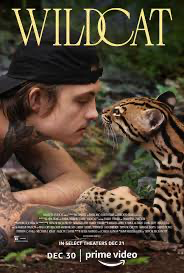WildCat Documentary movie Review/ WildCat recenzja filmu dokumentalnego

https://www.imdb.com/title/tt13622204/
“Wildcat” – When You Expect Cute Jungle Cats, but Get a Brutal Fight with the Mind
Looking for something light to watch, I was browsing Amazon Prime and stumbled upon a documentary called “Wildcat.” The title and thumbnail promised wild ocelots in the Amazon rainforest, and without even reading the description, I hit play, expecting nearly two hours of adorable jungle kittens.
Well… that’s not what I got.
And honestly? I’m glad it wasn’t.
“Wildcat” is a deeply emotional documentary that’s less about wildlife and more about mental health, trauma, and survival. Its main subject is Harry Turner, a young British soldier who was deployed to Afghanistan at just 18. When his tour ends, he returns home to the UK but can’t adjust to civilian life. He struggles with severe PTSD, self-harm, and multiple suicide attempts. With what little energy he has left, he decides to leave everything behind and travels to Peru — searching not just for escape, but for a reason to keep living.
In the depths of the Amazon, Harry meets Samantha Zwicker, an American biologist and wildlife conservationist. Together, they establish a wildlife rescue center, dedicated to saving trafficked and orphaned animals, especially wild cats like ocelots.
Then comes Keanu — a baby ocelot.
From the moment Harry meets this tiny predator, he finds a purpose: to raise and rehabilitate Kea for release back into the wild. Over the course of a year, this mission becomes Harry’s lifeline. The bond he forms with Kea isn’t just touching — it’s life-saving. Kea becomes the reason he gets out of bed, the anchor in his chaotic mind.
Days turn into weeks, weeks into months. As Kea grows stronger and more independent, Harry’s inner struggle remains. Despite moments of joy and the unwavering support of Samantha, the weight of trauma continues to pull him down. The film doesn’t shy away from showing his darker moments, making it painfully honest and sometimes hard to watch.
“Wildcat” is not a traditional nature documentary. It’s a raw, human story set against the wild backdrop of the jungle. It captures what it means to battle your own mind, to try — sometimes clumsily, sometimes desperately — to heal. Yes, parts of the film may feel staged or edited for emotional impact, but overall, it reflects the unpredictable and messy journey of mental recovery.
What makes the film even more powerful is how it subtly tackles male vulnerability, depression, and the silent struggle many men go through — often alone. It explores how, for some, self-harm becomes the only way to feel anything when depression numbs the emotional core.
At the same time, we also learn a lot about ocelots — how they live, interact, and form surprising bonds with humans despite being wild animals. That layer of nature and conservation adds balance and beauty to the heaviness of the story.
My rating: 8/10.
This is a film worth watching — even if you’re not into wildlife documentaries. Because in truth, “Wildcat” isn’t just about wild cats. It’s about a wild heart trying to find peace, and the painful, beautiful process of learning to stay alive.

https://www.imdb.com/title/tt13622204/
“Wildcat” – kiedy myślisz, że oglądasz film o dzikich kotach, a trafiasz w sam środek ludzkiego piekła
Szukając czegoś lekkiego na wieczór, przeglądałem ofertę Amazon Prime. Wpadł mi w oko dokument pt. „Wildcat” — opis sugerował opowieść o dzikich ocelotach, więc z radością nastawiłem się na blisko dwie godziny uroczych ujęć małych kotów biegających po amazońskiej dżungli. No cóż… Dostałem coś zupełnie innego. I dobrze, że tak się stało.
„Wildcat” to poruszający dokument opowiadający nie tylko o dzikiej przyrodzie, ale przede wszystkim o walce z depresją i PTSD. Głównym bohaterem jest Harry Turner, były żołnierz armii brytyjskiej, który już w wieku 18 lat trafia na front wojenny w Afganistanie. Po powrocie do Anglii nie potrafi odnaleźć się w nowej rzeczywistości – próby samobójcze, lęki, emocjonalna izolacja… Jego życie rozpada się na kawałki.
W akcie desperacji decyduje się na ucieczkę – dosłownie – i wyrusza do Peru. Tam poznaje Samanthę Zwicker, amerykańską biolog i działaczkę na rzecz ochrony przyrody. Razem zakładają centrum rehabilitacji dzikich zwierząt w amazońskiej dżungli, które staje się nie tylko schronieniem dla ocelotów, ale też – symbolicznie – dla samego Harry’ego.
Najważniejszy wątek dokumentu to relacja Harry’ego z młodym ocelotem o imieniu Keanu. Zwierzę, które trafia do nich jako osierocony kociak, staje się jego celem, terapią, sensem dnia codziennego. Przez ponad rok Harry stara się przygotować Keanu do powrotu na wolność. W międzyczasie to właśnie kot – dziki, nieprzewidywalny, potrzebujący opieki, ale też wolności – pomaga Harry’emu mierzyć się z jego własnymi demonami.
To dokument pełen kontrastów: amazońska dżungla kontra ciemność w głowie bohatera. Radosne chwile z kotem kontra depresyjne epizody, które wracają jak bumerang. Nawet relacja z Samanthą – choć bliska – nie potrafi do końca wyciągnąć Harry’ego z emocjonalnej otchłani. Momentami ich współpraca wręcz zaczyna ją pochłaniać.
„Wildcat” to coś znacznie więcej niż tylko przyrodniczy dokument. To film o próbie przetrwania w świecie, który nie daje drugich szans. O samotności, traumie i walce – nie tylko o życie dzikich zwierząt, ale też o własną duszę. Narracja bywa nieuporządkowana, miejscami sprawia wrażenie inscenizowanej, ale wszystko to oddaje chaos wewnętrzny, z jakim zmaga się Harry.
Czy ten film jest łatwy w odbiorze? Zdecydowanie nie. Czy warto go zobaczyć? Bez dwóch zdań tak. To jeden z tych dokumentów, które zostają z widzem długo po seansie. Pokazuje męskie emocje bez filtra, depresję bez upiększeń i więź między człowiekiem a zwierzęciem, która czasem potrafi uzdrawiać bardziej niż jakakolwiek terapia.
Moja ocena: 8/10
To nie jest zwykły film o przyrodzie. To opowieść o kruchości, o odwadze i o tym, że nawet w najbardziej dzikim świecie – czy to w dżungli, czy we własnym umyśle – można znaleźć coś, co warto uratować.